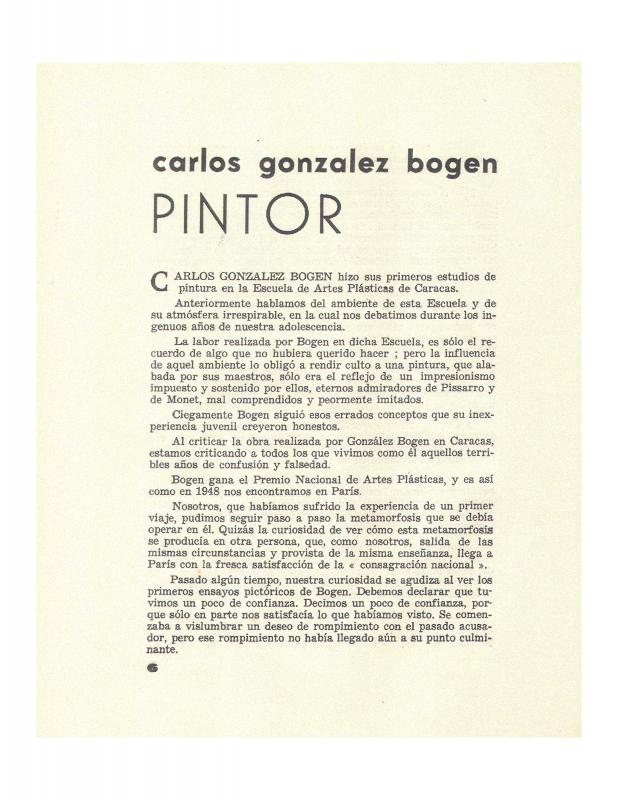Los Disidentes was a group started in Paris in 1950 by a number of Venezuelan artists and writers who lived there from 1945 to 1952. From their home base in Paris they decided to challenge the official education provided by the Escuela de Artes Plásticas de Caracas, which was based specifically on landscape painting and nativist art. In the spirit of their name, Los Disidentes sought to breathe new life into traditional and academic art through an assimilation of the values espoused by European abstraction. The painters in the group included the author of this essay, Alejandro Otero (1921–90) (see also “Del arte abstracto” [doc. no. 813611], “Poetas: Críticos de arte” [doc. no. 813445], “Las ‘placas al mérito’ y la juventud” [doc. no. 813429], and “Gastón Diehl promulga y espera una resurrección del espíritu impresionista en Venezuela?” [doc. no. 813625]), Pascual Navarro, Luis Guevara Moreno, Carlos González Bogen (“La escuela ‘de los paisajistas’ de Caracas” [doc. no. 813695] and “‘De nuevo’ Los Disidentes” [doc. no. 813667]), Mateo Manaure (“Carlos González Bogen: Pintor” [doc. no. 813583]), Narciso Debourg (“En torno a la pintura de hoy” [doc. no. 813597]), Perán Erminy (“Alrededor de la historia de ‘Los Disidentes’” [doc. no. 813463]), Rubén Núñez, Dora Hersen, and Aimée Battistini, as well as J. R. Guillent Pérez, who was a philosophy student at the time (“Lo latinoamericano y lo occidental [Parte I]” [doc. no. 813723] and “Lo latinoamericano y lo occidental: (Continuación)” [doc. no. 813478]). They were later joined by other Venezuelan artists such as Armando Barrios, Miguel Arroyo, Oswaldo Vigas, Omar Carreño, Alirio Oramas, and Régulo Pérez. They published a magazine, named after the group, Los Disidentes, which carried all their news, and appeared a total of five times.
In this essay the painter Otero, a member of Los Disidentes, uses Manaure’s experiences as a template to sketch a profile of the optimistic young Venezuelan (and Latin American) artists who came to Paris in the mid-1940s and were faced with the cultural crisis of postwar Europe. As in his other essays—which were also published in the group’s own magazine, Los Disidentes—Otero takes a decidedly avant-garde approach and (in his arguments and use of facts) reveals his commitment to the group’s ideas as expressed in the four editorials that appeared in the magazine’s five published issues; these editorials are essentially a statement of the group’s manifesto. In this essay Otero also reveals his vocation for teaching through his way of presenting and explaining the history of western, French, and Venezuelan art in order to provide some context for his discussion about Manaure. He also communicates the spirit of embracing “novelty” and the future, and projects the sense of leadership that can be seen in all his writings and other works.











